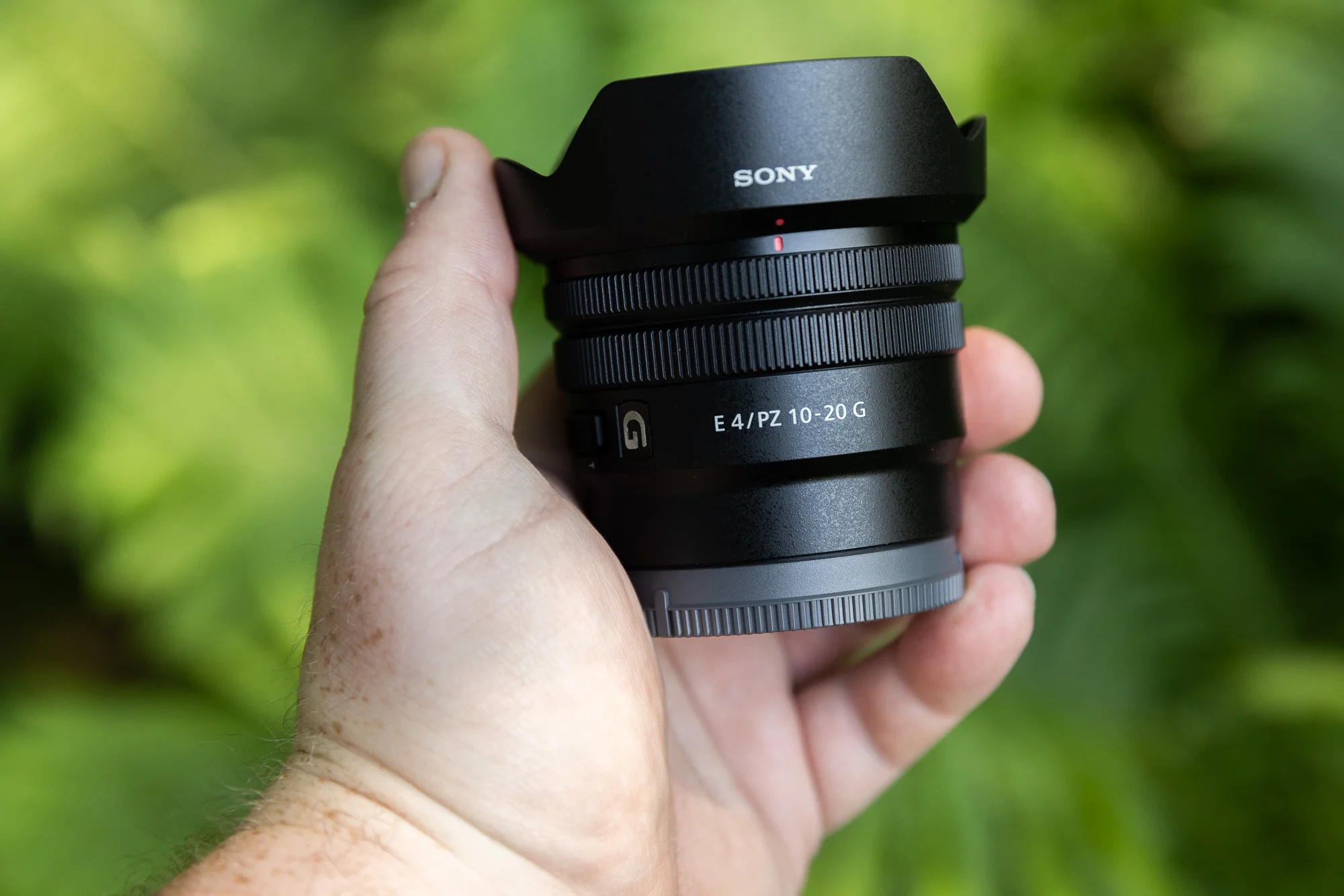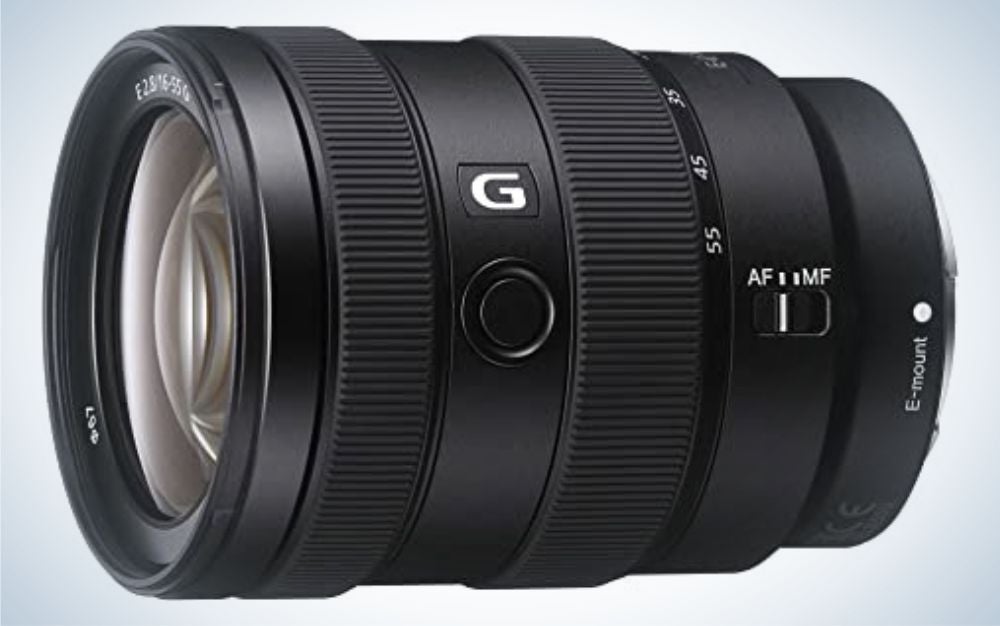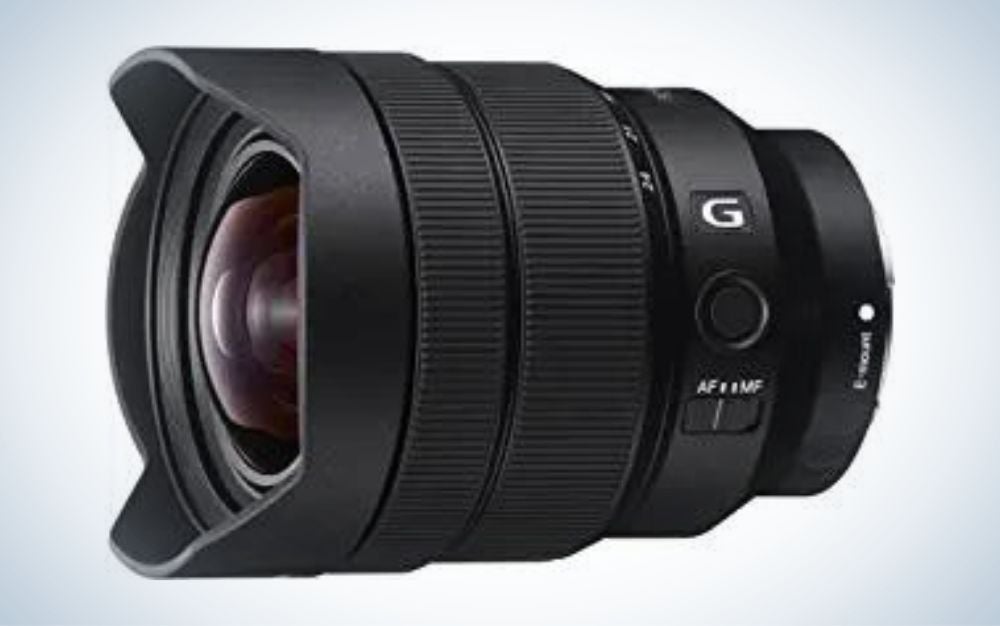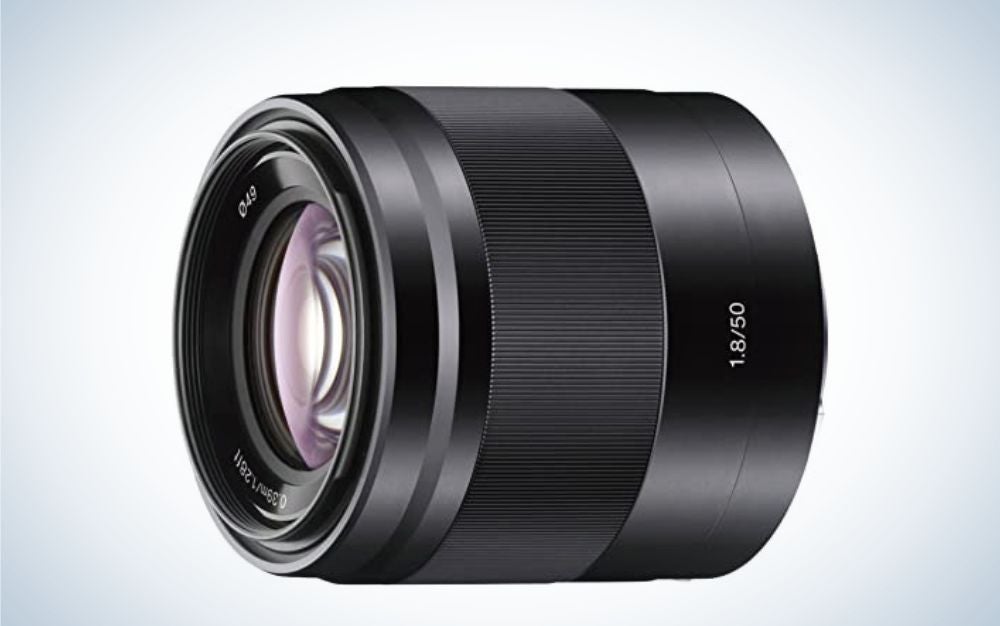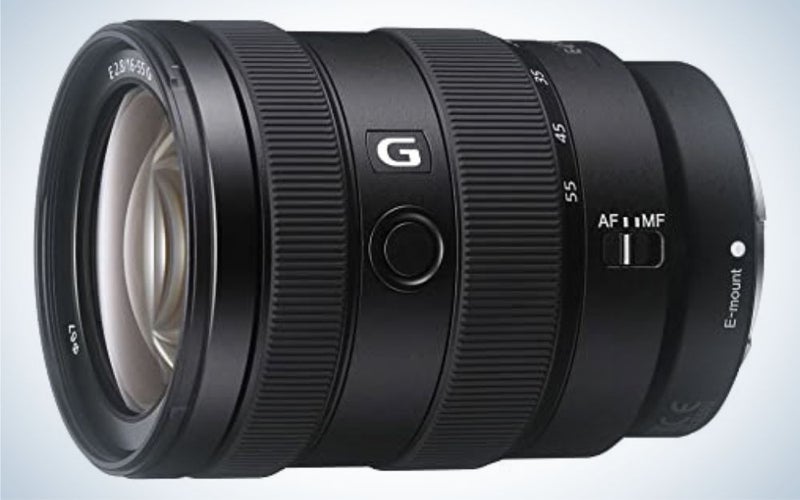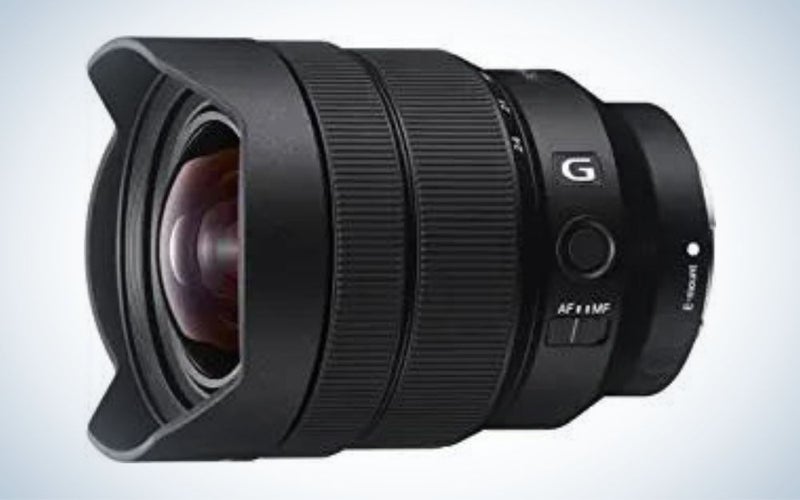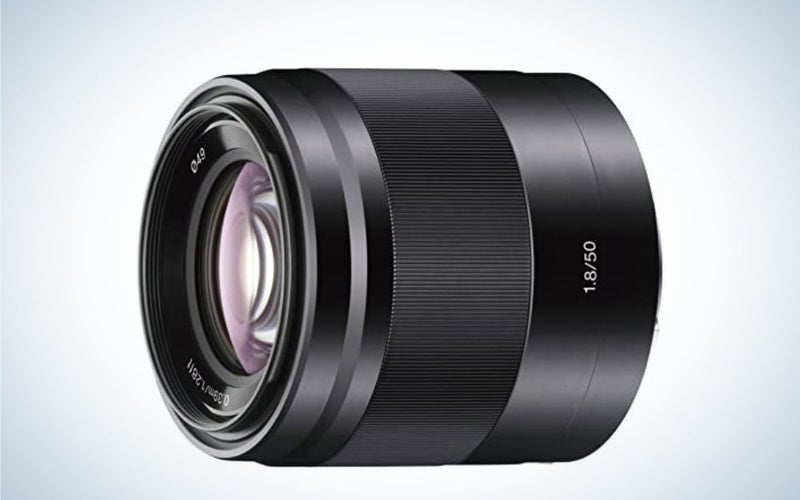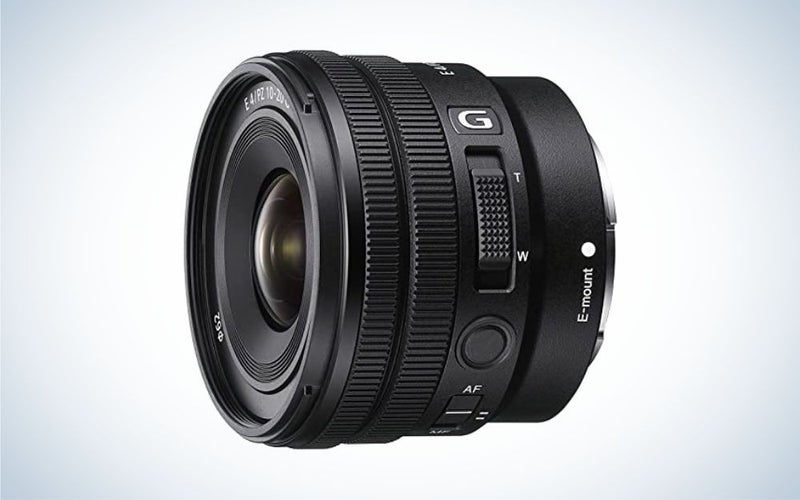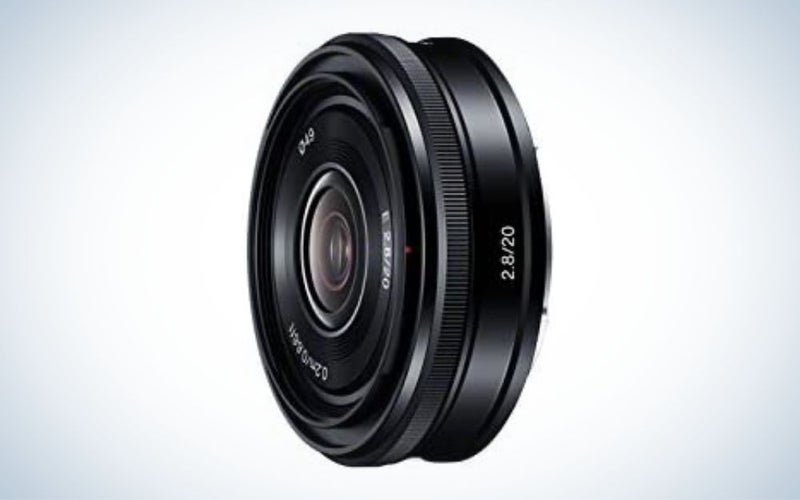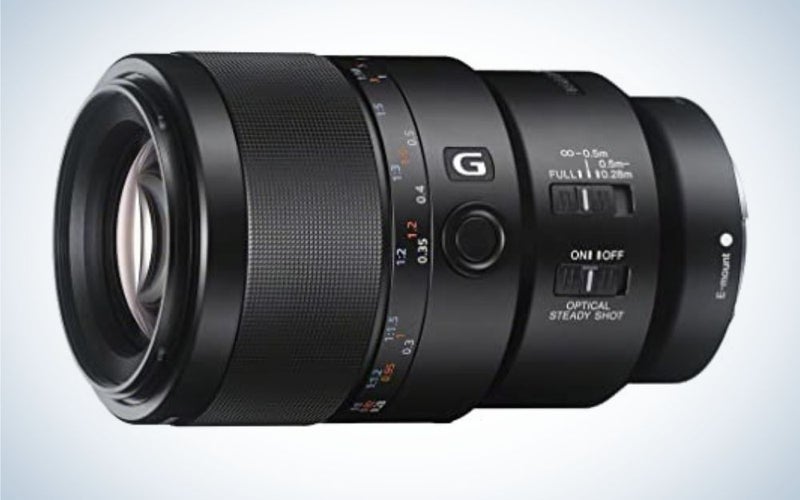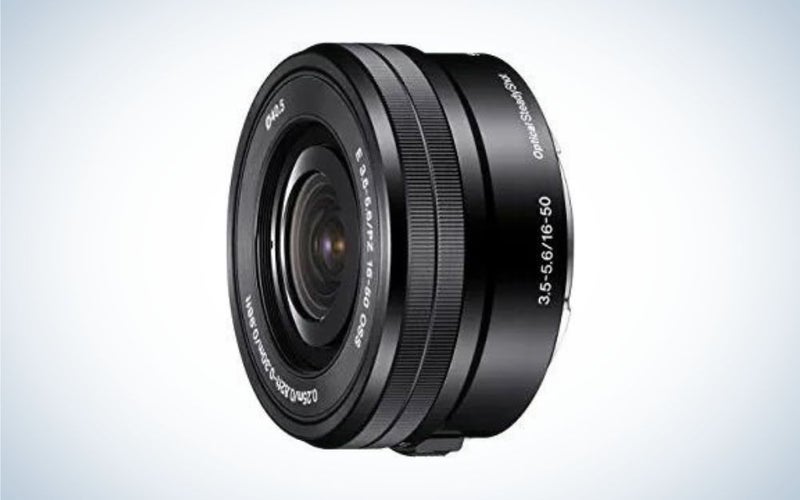We may earn revenue from the products available on this page and participate in affiliate programs. Learn more ›
Getting the right lenses for the Sony a6400 will allow you to take full advantage of this little camera. Released in 2019, the a6400 is a truly excellent camera with Sony’s exceptional autofocus and a 24.2-megapixel APS-C sensor. And despite all of its impressive specs, it’s relatively affordable, especially compared to its full-frame siblings. It’s a great device for travel, street photography, vlogging, or everyday use.
But, a camera is nothing without a quality lens. Luckily, there are lots of options for Sony APS-C cameras, ranging from wide-angle to telephoto and everything in between. Many offer professional quality at much more budget-friendly prices than their full frame counterparts. And, should you want to build up a kit that you can grow with, full frame lenses will also work on the a6400, giving you an even wider range of choices that you can use even if you upgrade your camera. No matter what you go with, the best lenses for Sony a6400 will help you document whatever you throw at it.
- Best overall: Sony E 16-55mm f/2.8 G
- Best landscape: Sony FE 12-24mm f/4 G
- Best portrait: Sony E 50mm F/1.8 OSS
- Best vlogging: Sony E PZ 10-20mm F4 G
- Best street photography: Sony E 20mm f/2.8
- Best macro: Sony FE 90mm f/2.8 Macro G OSS
- Best budget: Sony E PZ 16-50mm F3.5-5.6 OSS
How we picked the best lenses for Sony a6400
I have been involved in the photography industry in various capacities for nearly two decades. During that time, I have had the opportunity to use and learn about an extensive list of lenses, including Sony’s offerings. As a former photography instructor, I also worked with students on choosing the best gear as they grew their skills and kit.
When selecting the best lenses for a Sony a6400 I looked at a range of features and specs, but image quality was the most important. Following that, the size and weight, aperture range, and autofocus capabilities were also critical. Since the a6400 doesn’t have stabilization, I also looked for lenses that would offer that. And finally, as this camera is suitable for a variety of skill levels and budgets, I focused on lenses that would suit those different needs.
The best lenses for Sony a6400: Reviews & Recommendations
Best overall: Sony E 16-55mm f/2.8 G
Sony
Why it made the cut: This standard zoom is the sharpest lens Sony has made for APS-C cameras and it offers a bright, constant f/2.8 maximum aperture.
Key features:
- Weight: 1.09 pounds
- Dimensions: 2.87 x 3.94-5.3 inches
- Filter thread: 67 mm
- Minimum focusing distance: 1.08 feet
Pros
- Constant f/2.8 aperture
- Weather sealed
- Extremely sharp
- Very quiet autofocus
Cons
- No in-lens stabilization
Every photographer should have a standard zoom in their kit, which is a lens that includes 50mm (full frame equivalent) and a bit of wide-angle and telephoto. Sony’s APS-C standard zoom offers a full frame equivalent focal length range of 24-82.5mm, providing a bit more reach than the classic 24-70mm full frame standard zoom. The range makes this lens good for just about everything. It’s a workhorse perfect for travel, portraits, landscapes, and even some detail shots.
One of my favorite things about this lens is that it has a fast and constant f/2.8 aperture, meaning you won’t lose stops of aperture when you zoom in. For the price and category of this lens, that is a huge plus. And, that wide aperture will be helpful in low light conditions and give you more creative control over depth of field.
Sony didn’t skimp on the quality or features of this lens. It’s a pro-grade option for its crop sensor cameras. Most notable is the professional-level image quality. Images are very sharp and clear, showing more detail than any other Sony APS-C lenses, with edge-to-edge sharpness even when shooting at f/2.8. The build quality is also professional-level with full weather sealing. Combined with the fluorine-coated front element to ward off dust and fingerprints, you can worry less when using this lens.
The main downside is the lack of stabilization. The a6400 doesn’t have in-body stabilization, so you’ll have to fend of camera shake the old fashioned way with faster shutter speeds or a tripod. It’s also a bit pricey for an APS-C lens. But, the price does get you professional-level quality and features, making it an excellent buy despite the cost and lack of stabilization.
Best landscape: Sony FE 12-24mm f/4 G
Sony
Why it made the cut: It offers an ultra-wide perspective with an equivalent focal length of 18-36mm and a constant f/4 aperture in a weather sealed body.
Key features:
- Weight: 1.24 pounds
- Dimensions: 3.43 x 4.62 inches
- Filter thread: None
- Minimum focusing distance: 11.02 inches
Pros
- Full frame lens means you can use it if you upgrade cameras
- Excellent sharpness across the frame
- Constant f/4 aperture
- Fast and silent autofocus
Cons
- Noticeable vignetting
- Doesn’t accept filters
Though the Sony 12-24mm f/4 G lens is designed for full-frame cameras, it will work just as well on crop sensors. You will get an equivalent focal length of 18-36mm on your a6400, so not as wide as if you were to use it on a full-frame camera, but it’s still plenty wide for landscape photography. Plus, since the image circle covers a full-frame sensor, you won’t need to buy a new lens if you upgrade to an A-series body down the road.
As a G line lens, you get excellent image quality in a durable body. Images taken with this lens are extremely sharp, especially when stopped down. You will notice some corner softness when shooting at f/4, but that is to be expected at this focal length. It’s also less pronounced on a crop sensor than it is on a full-frame chip because you’re only using the middle part of the image circle. It can focus as close as 11 inches, allowing you to get fun wide-angle detail shots. And it’s weather sealed to protect against the elements, a must for landscape photographers.
Autofocus with this lens is fast and accurate. It’s also nearly silent, making it a good option for vlogging or other video work. While there is some focus breathing (a phenomenon in which the field of view changes slightly during focusing), it’s extremely minimal. And, thanks to Sony’s Nano AR Coating, ghosting and flares are minimal. Wide-angle lenses can suffer from intense flares, but that’s not the case here, which should please landscape photographers.
On the lens body, you’ll find a focus hold button, though, as with other Sony lenses, you can customize it should you want some other shortcut there. At 1.24 pounds and 3.4 by 4.6 inches, it’s not ultra-lightweight or compact, but it is smaller than comparable lenses. For example, the Sigma 12-24mm F2.8 DG DN Art weighs 1.75 pounds and measures 3.35 by 5.16 inches, which would feel extra bulky on the compact a6400.
Best portrait: Sony E 50mm F/1.8 OSS
Sony
Why it made the cut: With an equivalent focal length of 75mm and a wide f/1.8 aperture, this compact lens is capable of producing beautiful bokeh in your portraits.
Key features:
- Weight: 7.13 ounces
- Dimensions: 2.44 x 2.44
- Filter thread: 49 mm
- Minimum focusing distance: 1.28 feet
Pros
- Beautiful bokeh
- Built-in stabilization
- Fast max aperture
- Affordable
Cons
- No hard stops for manual focus
- No weather sealing
Sony’s 50mm for APS-C offers essentially the same angle of view you’d get with a 75mm lens on a full-frame camera. That makes it an ideal focal length for portraits. The slight telephoto reach– with the rounded seven-blade aperture–provides beautiful bokeh and shallow depth of field to isolate your subject from the background. It also allows you to give your subject some room instead of standing on top of them, which can put them more at ease.
Despite the very affordable price, this lens offers some excellent optics. There is essentially no distortion, so you won’t need to worry about facial features getting weird. While there is some slight vignetting, that can actually be an asset in portraiture. But, it is easy to remove if you don’t want it. Images are sharp and clear, though expect some softness on the edges when shooting wide open.
Sony included its Optical SteadyShot image stabilization in this lens, which helps if you need to handhold the lens in low light conditions. That is a plus since the a6400 doesn’t have any in-camera stabilization. And, with the fast f/1.8 aperture, you’ll be able to get shots in the fading light or indoors successfully.
As we’d expect from Sony lenses, autofocus is fast, accurate, and silent. Should you want manual control, that is, of course, an option, but unfortunately, it is electronic manual focus. That means there is no tactile feedback or hard stops on either end of the focus ring. As a result, it can make the manual focus process a bit annoying and slow down the process. But, for the price of this lens, along with its lightweight size, it’s a fantastic choice for those looking for a portrait lens for the a6400. And, should you have a preference in how your lens looks, this 50mm comes in both black and silver.
Best vlogging: Sony E PZ 10-20mm F4 G
Sony
Why it made the cut: This lightweight hybrid lens provides a 15-30mm equivalent focal length for a wide-angle perspective, making it easier to get yourself and the scenery in your vlogs.
Key features:
- Weight: 6.3 ounces
- Dimensions: 2.75 x 2.25 inches
- Filter thread: 62 mm
- Minimum focusing distance: AF: 7.92 inches | MF: 5.16 (wide) – 6.72 (tele)
Pros
- Very compact and lightweight
- Internal zoom
- Power zoom control for video
- Linear autofocus for quiet focusing
Cons
- No optical stabilization
If you are a vlogger or any kind of video shooter, having a wide-angle lens will be a valuable asset. The wide perspective makes it possible to get all of you in the frame and even include some surroundings. This Sony E PZ 10-20mm F4 G has a 35mm equivalent focal length of 15-30mm, which is an ideal range for going wide without dipping into fisheye territory. Beyond the focal length, Sony packed this lens with features that make it a perfect vlogging lens, no matter your content.
Sony claims it is the “world’s smallest ultra-wide APS-C zoom,” and at just 6.3 punches and only 2.75 by 2.25 inches, that statement seems feasible. It will be much easier to hold for long filming sessions because of how lightweight it is. Plus, the zoom and focus are internal. That makes this lens the perfect companion for a gimbal. And you will want to use a gimbal since it doesn’t have any optical stabilization, and the a6400 doesn’t have any in-camera stabilization either. Your video will be quite shaky otherwise.
The power zoom feature will also come in handy for video shooters. The zoom rocker on the side of the lens has variable speeds and allows you to zoom in or out smoothly and at a specific speed. It makes zooming much easier while recording. And thanks to the linear autofocus, focusing is nearly silent, so you won’t hear that annoying focus whir in your videos.
Though this lens has many features perfect for vlogging and video, it is also an excellent option for photographers. The image quality is great, with edge-to-edge sharpness. The f/4 aperture and wide-angle perspective won’t give you epic bokeh, but it can focus as close as 5.1 inches when using manual focus, which helps create a nice shallow depth of field. If you do want a faster aperture, Tamron’s 11-20mm F2.8 is a great alternative.
Best street photography: Sony E 20mm f/2.8
Sony
Why it made the cut: Weighing just 2.43 ounces, this pancake lens sticks out less than an inch from the camera, making it very low profile and easy to carry around.
Key features:
- Weight: 2.43 ounces
- Dimensions: 2.46 x 0.8 inches
- Filter thread: 49 mm
- Minimum focusing distance: 7.87 inches
Pros
- Ultra compact and low profile
- Affordable
- Compatible with ultra-wide and fisheye converters
- Good image quality
Cons
- No weather sealing
Like landscape photography, street photography benefits from a wide-angle lens. This particular lens offers the angle of view you’d get from a 30mm lens on a full-frame body, which isn’t so wide that you get intense distortion but still provides a broad view. As a result, you’ll be able to capture a variety of dramatic street scenes.
What makes this lens best for street photography is the pancake design. It weighs almost nothing and only sticks out 0.8 inches. The a6400 is a compact little body, so it pairs very naturally with this stubby little lens. You’ll barely notice it on the camera, making it easier to carry around all day. And it can even slip inside a coat pocket easily. The slim size also means it’s discreet, so you can photograph candid portraits without getting noticed as much as a larger setup would.
Though not groundbreaking, the image quality from this lens is very strong. Images are sharp at f/2.8, but they get much better when stopped down. So, if you want to maximize sharpness, we’d recommend shooting at f/5.6 or f/8 or so with this lens. That said, the f/2.8 aperture is helpful in low light, a frequent occurrence in many street photography situations. Images are still clear enough at that aperture to use, so don’t worry about being limited.
Unfortunately, there is no weather sealing on this lens, so you’ll want to avoid getting caught in a downpour. But, the lower price point and slim design make it worth it in our book. And, in case you want something even wider but don’t want to spend money on another lens, it’s compatible with Sony’s ultra-wide-angle and fisheye converters. Of course, that will take away the slimness of the lens, but it will give you a 24mm equivalent focal length for more versatility.
Best macro: Sony FE 90mm f/2.8 Macro G OSS
Sony
Why it made the cut: For those crisp shots of tiny details, the Sony 90mm macro lens offers excellent image quality, optical stabilization, and highly accurate autofocus.
Key features:
- Weight: 1.32 pounds
- Dimensions: 3.11 x 5.14 inches
- Filter thread: 62 mm
- Minimum focusing distance: 11.02 inches
Pros
- 1:1 macro reproduction
- Also compatible with full frame Sony cameras
- Extremely accurate autofocus
- Push-pull manual focus switch
Cons
- Loses sharpness when wide open
Macro photography is a genre that can produce dramatic results as long as you have the right skills and gear. This Sony macro lens meets that need and offers a 1:1 macro reproduction with a full-frame equivalent focal length of 135mm on your a6400. 1:1 means the lens will render the subject the same size on the image sensor as it is in real life. The higher the ratio, the more the magnification. This lens’s telephoto focal length allows you to keep your distance from your subject, preventing shadows from casting on it, and you won’t scare any live creatures away.
The optical quality of this lens is truly excellent. Images will be very sharp and clear all the way to the edges. However, you will want to stop down to maximize sharpness, as it isn’t the sharpest wide open. Luckily it comes with Sony’s Optical SteadyShot image stabilization to improve low light shooting, so you don’t need to rely entirely on aperture for more light. Depth of field becomes scarce when shooting up-close, so smaller apertures are often essential.
One of the most significant assets of this lens is just how accurate its autofocus is. Since macro photography usually only has a sliver of a scene in focus, it is critical to have precise focus, and this lens delivers. It also has a focus limiter with three settings–between 11 to 19.7 inches, 19.7 inches to infinity, or full–so your camera doesn’t need to search for focus across the entire scene. It speeds up the already speedy autofocus.
The manual focus system also lens itself to precision. Unlike many mirrorless lenses, Sony kept the focusing distance and magnification scale markings and hard stops on the focusing ring, which makes manual focus much better. And it’s more accurate than other options, so you can really fine-tune the focus of your shots.
Best budget: Sony E PZ 16-50mm F3.5-5.6 OSS
Sony
Why it made the cut: At a very affordable price, the Sony 16-50mm offers a versatile zoom range in a compact design.
Key features:
- Weight: 4.09 ounces
- Dimensions: 2.55 x 1.18-2.04 inches
- Filter thread: 40.5 mm
- Minimum focusing distance: 9.84 inches
Pros
- Very compact design
- Versatile focal length
- Includes optical stabilization
- Affordable
Cons
- Image quality isn’t outstanding
Sony’s a6400 is an affordable camera, so it only makes sense to want an affordable lens to go with it. Sony’s E PZ 16-50mm F3.5-5.6 OSS fits the bill. On any Sony ASP-C camera, you get an equivalent focal length of 24-75mm, which fits into the versatile standard zoom category. It has you covered from the wide-angle to telephoto spectrum, so you won’t need to change lenses as often.
Another attractive feature of this lens is its compact design. It weighs a paltry 4.09 ounces and, at maximum extension, only sticks out 2.04 inches from the camera. Collapsed, it only extends 1.2 inches, which is impressive given the focal length. It will be an excellent partner to the slim a6400 and easy to toss in your camera bag for trips.
The lens features Sony’s Optical SteadyShot image stabilization, improving its lowlight abilities. That’s a plus since the variable max aperture goes from f/3.5 to f/5.6 when zoomed in. In addition, the autofocus is fast and silent, a plus, especially for video use. There’s also a very minimal focus breathing, another good thing for video.
Unfortunately, there are some caveats with the low price comes. First, the lens has to extend when you power the camera on, and it is not a quiet process. You may not want to zoom in when recording video because of that. And, as should be expected from a lens this price, the image quality isn’t anything to write home about. It’s not awful, but the edges show softness across the aperture range. But, despite those things, it is still a great starter lens or for those who want something better than a phone for family snapshots or vacations.
Things to consider when shopping for the best lenses for Sony a6400
Prime or zoom
One of the first decisions you need to make when choosing the best lenses for a Sony a6400 is whether you want a prime or zoom lens. Choosing between these lens types comes down to personal preference and your shooting style, as there are pros and cons to both.
Prime lenses have one single focal length, so you have to move your body with the camera to change your angle of view and perspective. Because less glass needs to fit inside, they are generally cheaper and of higher quality. They also tend to be lighter and more compact compared to zoom lenses that cover the same focal length. But, they are less versatile since you can’t just twist the lens to zoom in or out.
Zoom lenses offer a range of focal lengths. That makes them more versatile and keeps you from changing your lens as often. But, they tend to be bulkier and more expensive. And while the quality of zoom lenses is getting better, prime lenses typically offer superior image quality. If you’re not sure where to start, a kit zoom can provide a very cheap way to explore the different focal lengths to see which you prefer. Then you can invest in a more expensive prime or zoom later.
Focal length
Focal length is critical because it determines the angle of view. Plus, it also has a role in determining depth of field. It has a significant impact on how your images will look, so it’s important to put some time into considering this. It helps if you know the genres of photography you will mostly be using the lens for, as different situations call for different lenses.
It’s also important to note that focal length is measured according to a full frame sensor. APS-C sensors have a smaller image area, so it effectively crops in from what a full frame camera would see. The Sony a6400 has a 1.5x crop factor, meaning you need to multiply the focal length by 1.5x to get the effective focal length. So, for example, a 50mm lens will act like a 75mm on an a6400, at least when it comes to angle of view.
There are three main categories of focal lengths: Wide-angle, normal, and telephoto. A normal lens is called such because it most closely replicates human vision. A 50mm is widely accepted as the normal focal length, so you would need a 35mm lens for the same perspective on an a6400.
As the name suggests, wide-angle lenses provide a wide angle of view. They are best for subjects like landscapes, architecture, or group photos. Wide-angle lenses have a wider angle of view, which means you’ll have to get much closer to fill the frame with a subject. They also result in a deeper depth of field–when all other factors are equal–compared to telephoto lenses.
Telephoto lenses have a narrow angle of view and high magnification. So, like your side view mirrors, objects will appear closer than they are. That’s why telephoto lenses are so great for wildlife and sports photography since you can’t generally get close to your subject. They are also capable of very shallow depth of field, which helps isolate your subject from the background.
Aperture
While every lens will be capable of a range of apertures, it’s essential to pay attention to its maximum aperture. The maximum aperture will impact a lens’s low light abilities, as a wider one will let in more light. A wider aperture is also one factor in creating a shallow depth of field, helping to keep the focus on your subject instead of the background. So, if you know you’ll want to use your lens in situations with less than ideal light or like to have nice bokeh and shallow depth of field, look for a wide maximum aperture such as f/2.8.
Sony or third-party
Sony makes lots of fantastic first-party lenses, but there are lots of other options out there that are compatible with your a6400. Third-party companies can offer unique focal lengths and lower prices, so it can be a good way to get something different or just save a big chunk of money.
We’ve stuck with Sony lenses here but have mentioned third-party options along the way. If you like a focal length but not the price, it’s always worth checking if there are third-party offerings with equal quality and features. That said, some third-party options are affordable because they don’t offer features such as autofocus or require manual aperture control. And while there are truly excellent third-party lenses, some are quite bad. As a result, we suggest you always do your research before purchasing third-party lenses.
Additional features
Beyond the main specs, there are some additional things you may want to consider:
- Size and weight: If you plan on traveling with the lens, you may want to focus on options that have a slim and lightweight form factor. This may also be true if you are a videographer using a gimbal, as you won’t need to get as robust of a gimbal if you have a lighter kit.
- Weather sealing: If you like adventure and want to use your new lens to document things, weather sealing will be nice to have.
- Optical stabilization: Since the a6400 doesn’t have in-camera stabilization, it may be important for you to have a lens with stabilization. It will help with low light performance and will also help some with smoothing out your videos.
FAQs
How much do lenses for Sony A6400 cost?
How much lenses for the Sony a6400 cost depends entirely on the lens. You can find lenses for the a6400 as low as $250. But, since you can also use full frame lenses on this APS-C camera, you could spend upwards of $3,000 on a lens if you go with the high-end Sony GM line.
Which is the best travel lens for the Sony a6400?
The best travel lens for the Sony a6400 is somewhat dependent on the type of traveling you do and what types of images you like to take, but our budget pick–the Sony E PZ 16-50mm F3.5-5.6 OSS–is an excellent travel lens. It is very compact, which will keep your pack from getting too heavy. And as a standard zoom lens, it offers both wide-angle and telephoto, meaning you won’t have to bring more than one lens to cover different focal lengths. And the budget-friendly price means you won’t have to worry as much about something happening to the lens.
If you want more quality for your travel photos, the Sony E 16-55mm f/2.8 G offers nearly the same focal length range–with a little extra reach–and has higher image quality. It will cost you more and isn’t as compact but will produce stunning images.
Do you need a lens for the Sony a6400?
Yes, you do need a lens for the Sony a6400. The a6400 is an interchangeable lens camera, meaning you can remove lenses and swap in different ones. Without a lens, you will not be able to make images. Although there are extra costs associated with them, interchangeable lens cameras offer more creative control and versatility.
If you are just buying your camera, you can buy bundles that include both the camera and a lens. Generally, the lenses that come in kits aren’t as high quality as what you can buy separately, but Sony does have some good kit options, such as the 50mm lens linked above.
Is Sony a6400 good for product photography?
The Sony a6400 is good for product photography. It offers 24 megapixels and excellent autofocus, so your product photos will have plenty of detail. And it’s a great camera for video, making it possible to record high-quality videos for your Etsy listings. But the biggest asset is the range of lenses you can buy for this camera. Of course, a quality camera is essential, but quality lenses are perhaps more important, especially for product photography. There are plenty of Sony E mount lenses that will help you capture fantastic product photos, no matter what your products are.
Can I use Canon lenses on the Sony a6400?
You can use some Canon lenses on the Sony a6400 if you have a lens adapter. However, we would only recommend doing this if you already have Canon lenses and want to switch over to Sony, as opposed to buying new lenses for your a6400. Also, not all Canon lenses will work with every adapter, so you need to double-check that the lens you have will be compatible with the adapter.
Different levels of adapters are available, depending on how much you want to spend and what features you want. More expensive options allow for communication between the lens and camera, so you can use autofocus and control the aperture via the camera. Cheaper alternatives will require you use only manual focus and will need to change the aperture on the lens.
Final thoughts on the best lenses for Sony a6400
There is a wide range of lenses available for the a6400, especially when you factor in full frame and third-party options. Of course, the best lens for you will depend on what you like to take pictures of and your photographic style, but we think the Sony E 16-55mm f/2.8 G is the most versatile option available, with some of the sharpest optics in a Sony APS-C lens.
